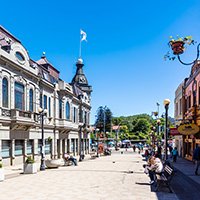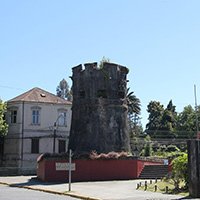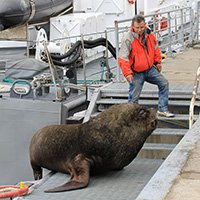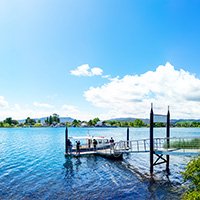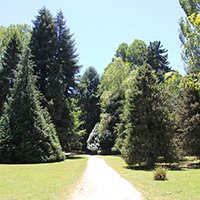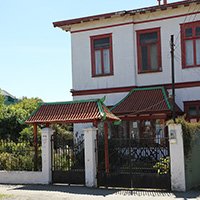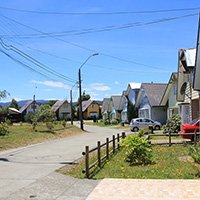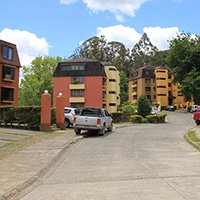This article focuses on things that are unique to Valdivia. So if you are new to Chile, check the guide to the country too.
When?
If you are coming as a tourist, the week of La Noche Valdiviana or anytime between November and March is sure to guarantee you good weather. But if you are coming to settle down, January to April would be the worst time because tourists and arriving university students completely saturate the rental market. Also keep in mind that everybody is unavailable during the long national holidays in September.

Climate
The Valdivian oceanic climate is similar to New Zealand and the state of Washington: dry hot summers and mild rainy winters (see the climate data). Winter temperatures rarely go close to zero and stay in the 5–8 ºC (41–46 ºF) range in the coldest months and summer temperatures almost never reach 30ºC (85 ºF). So there are no extremes and the weather is quite comfortable all year round.
Valdivia is nicknamed “Valdilluvia” for being a rainy city. While the statistics for winter rainfall can look scary, the storms often come at night and you can catch some hours of sun during the day. Valdivia is not the kind of city where all you see is a gray overcast sky for a month. Here's the temperature and sunshine data compared to other cities:
| Summer daily mean, ºC (ºF) | Winter daily mean, ºC (ºF) | Sunshine hours | Days with precipitation | |
|---|---|---|---|---|
| Valdivia | 18.2 (64.8) | 7.8 (46.0) | 2,018 | 177 |
| Auckland | 19.1 (66.4) | 10.9 (51.6) | 2,003 | 136 |
| Seattle | 18.7 (65.7) | 5.6 (42.0) | 2,170 | 152 |
| Toronto | 22.3 (72.1) | -3.7 (25.3) | 2,066 | 145 |
| New York | 24.7 (76.5) | 0.3 (32.6) | 2,535 | 122 |
| London | 19.6 (67.3) | 6.8 (44.2) | 1,632 | 109 |
| Amsterdam | 17.6 (63.7) | 3.4 (38.1) | 1,662 | 132 |
| Berlin | 19.2 (66.6) | 0.6 (33.1) | 1,626 | 101 |

Rent
See the general advice about renting in our newcomer's guide to Chile.
Here's the map of all neighborhoods (barrios) recommended for expats (click on the green areas to see names). Isla Teja or one of the riverside neighborhoods near the city center are the very best ones.
A "casa" is a family-sized house, while a "cabaña" is a smaller one, targeted towards tourists and students. So "cabañas" usually have worse construction quality and thermal insulation. They also often lack wood stoves and use smelly wick kerosene heaters. Usually installing a stove is not an option for your landlord, so you can opt for an odorless kerosene heater (brand name Toyotomi) — either laser-cleaned or fully vented. It's also perfect for apartments because central heating is not always warm enough.
Valdivian classifieds:
- Yapo.cl
- Vivastreet.cl
- Mitula.cl
- Arriendos Valdivia on Facebook
Transportation
Most of the time you won’t need a car to travel around the city and its surroundings due to an excellent network (see the route map) of buses (micros) and route-based taxis (colectivos). Keep in mind that all of them are cash-only and it's better to have some coins on hand.
Local taxis are also cash-only and they always use the taximeter. You can often find them on the supermarket parking lots waiting to help get your groceries home. There's also a taxi app but it's new and doesn’t always work. One of the most readily available taxi services is Taxi Scorpio (+56 63 221 0700). The average ride is CL$2,000–3,000, but it's almost CL$25,000 to the airport because it's located 25km (15mi) from the city. The official airport transfer van is just CL$4,000.
Food
Valdivia has a wide selection of cafes and restaurants. Most of them are located in the downtown and on the Teja island. Lunch menu prices typically range from CL$4,500 to CL$8,000 depending on the place. It usually includes a soup or a salad, a main course, and dessert. Both cafes and bars usually serve lunch from 1 to 3 pm.
You’ll find dozens of sushi places, though the Chilean version of sushi might not be what you're used to: lots of cream cheese, green onions, the ever-present avocado, and sometimes it can even have beef.
Here is the map of our favorite places. Click the button in the top left corner to see the list:
You can also order food from many restaurants and supermarkets via the delivery service PedidosYa. For now they don’t accept neither foreign cards nor Chilean Transbank RedCompra cards, but it’s possible to pay with cash (you will also need some cash to tip because their app doesn't allow for tipping). Use the code "RF-YQFH-RP47" for a CL$5,000 discount on your first order.
Shopping
The riverside market is open all year long, selling freshly caught fish and other sea creatures. From spring to autumn you can buy fresh fruits and berries both at the market and on several street corners. The best selection of local produce with the best prices can be found at the open air farmer's markets located in different parts of the city on different days.
There are many supermarkets in the city:
- Jumbo — The most expensive grocery store in the city but the place to go if you need something imported and fancy.
- Líder — Two stores, the larger one is probably the best for high volume shopping.
- Unimarc — Multiple stores, more expensive than Líder but also more messy.
- Santa Isabel — Two stores, the most affordable ones but limited to basic goods only.
- Teja Market — A bit overpriced store on the Teja island.
You can often see taxis waiting near the largest supermarkets — a great option to buy in bulk without having a car. If you are searching for some rare items, look for small specialized stores inside the "galerías" — the first floors of many buildings in the city center. For example, the vegan store is located at Galería La Reconquista, and for various small electronics, you should check the stores at the Galería Cristal.
Home decor, furniture, and construction materials are sold in:
- Sodimac — A big home and building supply store, but the furniture there is mediocre.
- Online in Sur Diseño, Easy — See our guide to online shopping.
- CasaIdeas (in the mall) — Household items with IKEA-like minimalistic designs.
- Hardware stores (ferreterías) like Ferretería Alemana downtown.
Many local stores and services have Facebook pages instead of websites. You can use Facebook search to find what you need (for example, "masaje Valdivia") or you can do a search in the city's main classifieds group: Avisos Valdivia.

Events
You can find anything from small university expos to cinema, music, and dance festivals. There are also frequent fairs in Parque Saval — usually centered around a specific theme like food, beer, chocolate, or gardening.
Places to find events:
- Disfruta Eventos Sur
- Posters and flyers in cafes
- Posters at Que Leo bookstore
- Announcements on university public news boards
- Event flags on Pedro de Valdivia bridge (to Teja island)
- Carpa de la Ciencia
- Corporación Cultural Municipal Valdivia
- Mutantes Producciones
- Productora Ecos del Bosque
- Facebook events discovery page
Tech events:
- Talks and workshops in Nube Coworking
- BeerJS meetup (monthly)
- 9punto5 conference about remote work (September)
- Global Game Jam (January)
While you're still learning Spanish, check out the English speaking meetings. If you speak German, you could also search for German speakers because lots of Germans have been moving to southern Chile since the 19th century.
Healthcare
- Clinica Alemana — the largest private hospital, also the most expensive one
- Megasalud — the second largest private clinic
- Surmedica — doctor offices and some medical services, including MRI
- Edificio Médico Beauchef — doctor offices
- Hospital Base Valdivia — public hospital
Doctors often work in multiple clinics, and a visit to the same doctor will cost you more in Alemana than in Surmedica.
Some English-speaking doctors:
- Dr. Pedro Aravena — dentist
- Dr. Ignacio Croquevielle Goycolea — ophthalmologist
- Dr. Edwin Krogh — psychiatrist focused in mindfulness-based therapy
- GAAP clinic — non-profit veterinary organization from Canada
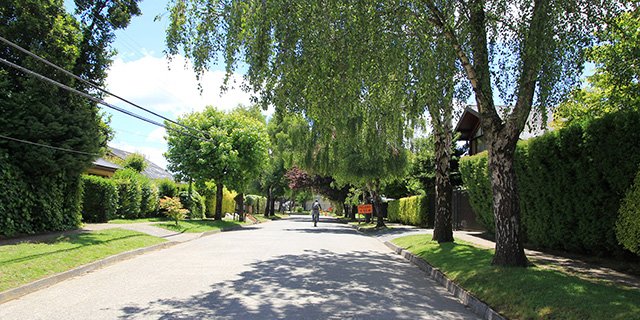
Safety
The city is generally safe. You can walk through downtown at night and there is little to no fencing in the good neighborhoods. Violent crime is low but you should watch your belongings anyways just to be safe — Chilean criminals are master thieves. It is not recommended that you leave valuable items in cars.
Compared to the northern parts of the country, Los Ríos and Valdivia rarely get earthquakes. It may be counter-intuitive but the frequency of natural disasters makes sure that Chile is safe from them: small earthquakes work to test the infrastructure and the society's response.
See more about safety in our newcomer's guide to Chile.
Internet access
Telefónica del Sur is the best Internet provider. It's very stable and has professional support staff. For a 30 Mbps plan, the average speed to servers in California is 15–18 Mbps for download and 8-10 Mbps for upload. Ping to game servers in New York is around 100–120ms.
Open WiFi is available at and near the Dreams hotel.
